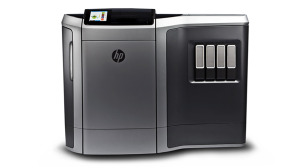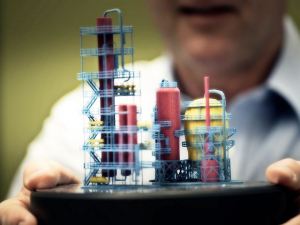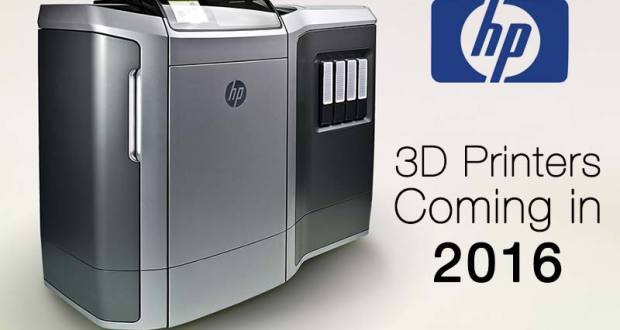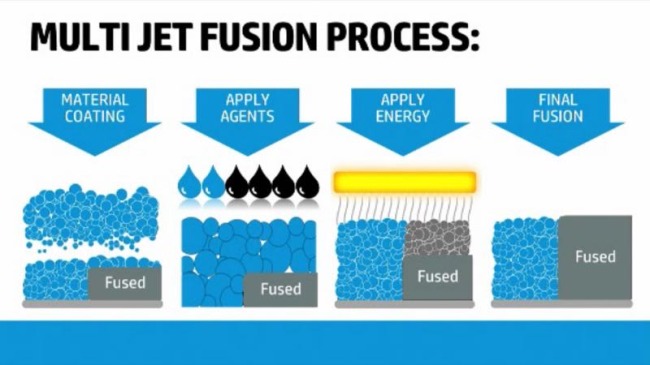We’ve been waiting for HP to make some formal announcements regarding 3D printing, but the company has been mostly mum…until now. This week, they announced they are planning to release commercial HP 3D printers in 2016. HP’s take is that their advancements in printing technology will be most applicable, and profitable, in the commercial 3D printing space as opposed to the consumer 3D printer market. Enterprise solutions for 3D printing are definitely on the horizon, and companies like 3D Systems and Stratasys (who both manufacture 3D printers for small business all the way up to production applications) have already made inroads with their existing lines.
You could argue that 3D printing has already hit mainstream—and certainly consumer interest is picking up. HP’s involvement, however, has been murky at best. Since they are a technology leader (and multi-patent holder of various applicable print technologies), everyone has been waiting to see what the company was going to do to get into the market. On Wednesday, HP debuted its Multi Jet Fusion 3D print technology. HP Multi Jet Fusion technology is based upon the principle that you can print with greater attention to the various parts of a product—with control over part and material properties beyond those found in other 3D printing processes. That means HP 3D printers are going to be able to control texture, friction, strength, and elasticity, as well as electrical and thermal properties. If they pull that off, the result might be a dramatic leap in what’s possible with 3D material printing.
The State of the 3D Printing Industry As We See It
 According to some industry analysts, the shipment of 3D printers is expected to double each year through 2018, ending with a $13.4 billion market. 2015 is a critical year for 3D as it represents some serious attention being paid to the technology that hadn’t materialized in years prior. In addition, as many as 60% of enterprise-level business are already using or actively evaluating the use of 3D printing in their businesses. From our experience with several industrial manufacturers, 3D printing is rapidly going from “nice-to-have” to integral in the areas of rapid prototyping and product testing. Companies are using it to get finished products to the manufacturing stage more quickly and efficiently. Where it used to take days and weeks to get a functioning prototype in your hands, it now takes hours. 3D printing is definitely moving forward quickly.
According to some industry analysts, the shipment of 3D printers is expected to double each year through 2018, ending with a $13.4 billion market. 2015 is a critical year for 3D as it represents some serious attention being paid to the technology that hadn’t materialized in years prior. In addition, as many as 60% of enterprise-level business are already using or actively evaluating the use of 3D printing in their businesses. From our experience with several industrial manufacturers, 3D printing is rapidly going from “nice-to-have” to integral in the areas of rapid prototyping and product testing. Companies are using it to get finished products to the manufacturing stage more quickly and efficiently. Where it used to take days and weeks to get a functioning prototype in your hands, it now takes hours. 3D printing is definitely moving forward quickly.
HP’s 3D Printing Challenge
While 3D printing isn’t new, it is reaching new areas of efficiency and productivity. The big question now is whether or not HP’s late entry into the market will bring with it enough new advances to keep up with (or even leapfrog) the competition in the enterprise market, or whether they will be facing an uphill battle to claim future marketshare. Given that HP made such an early announcement, skepticism is at an all-time high. Still, according to the documents announced by HP, their printing technology should offer new thermal jet techniques and fusion agents not yet seen in the marketplace and give them a formidable solution for enterprise 3D printing. When you view the HP video that demos the Multi Jet Fusion printer, it builds using layers of material deposited on top of each other—even going so far as to describe printing an electromechanical device in a single pass with no assembly required. That would be impressive indeed.
Breakthrough economics
Breakthrough economics
New quality levels
New quality levels
Full-color 3D solutions
Full-color 3D solutions

HP’s Multi Jet Fusion 3D print technology can handle multiple colors as well as intricate detail, textures, and (eventually) materials like metal and ceramics.
HP claims they have current prototypes already in use that exceed the capabilities of what’s currently available in the enterprise market. HP is claiming that its 3D printing technology will allow companies to complete jobs in 1/10th the time and at a much lower price point (currently, enterprise level 3D printers can cost upwards of $1 million per system). The new HP 3D printing unit will reside at in HP Inc (see our article on the splitting of the HP company into two divisions). HP will start in the enterprise market (going after service bureaus) with plastics-based materials, but they have indicated that metals, ceramics and other materials won’t be far behind. Eventually, HP will also enter the consumer 3D printer market when they can scale back the technology.
So what do you think? Can HP make a dent in the 3D printer market or are they too late to the table?
 CopierGuide Copier and Multifunction Printer Leases and Reviews
CopierGuide Copier and Multifunction Printer Leases and Reviews






